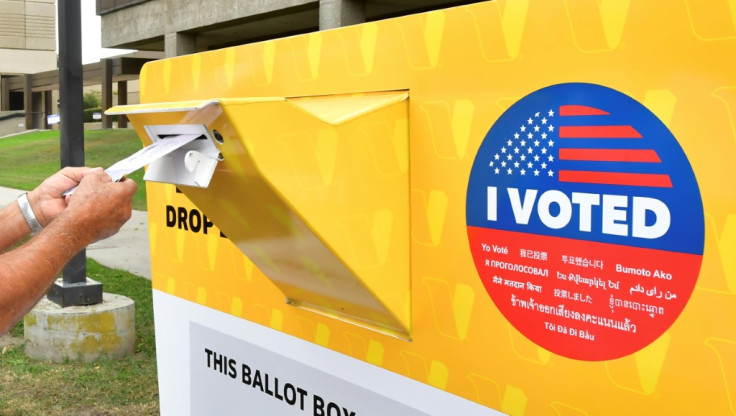
As the Latino population continues to grow in the U.S., so does the amount of eligible voters and, therefore, the demographic's influence in the elections' outcome.
According to the Pew Research Center, about 34.5 million Hispanics could cast a ballot in next year's elections, being the fastest-growing ethnic group in the U.S. electorate since the last midterm elections. It is expected the group will represent over 14 percent of the electorate.
However, Latinos have historically turned out to vote in much lower levels than other groups. Separate data from the Pew Research Center showed that 47 percent didn't vote in any of the last three elections (2018, 2020 and 2022), a much higher figure than the country average, 30 percent.
Moreover, 33 percent voted in one or two elections, compared to 34 percent overall, and the remaining 19 percent voted in all three of them, way below the 37 percent overall.

Voto Latino intends to change that, focusing its effort on educating younger generations to increase the amount of registered voters.
The Latin Times spoke to Ameer Patel, Managing Director of Civic Engagement for the organization, to understand more about its work, its goals for the next election cycle and the analysis behind its strategies to reach young Latino voters throughout the country.
This conversation has been edited for extension and clarity purposes.
What are Voto Latino's main goals for this election cycle as the date gets closer?
Our mission aims to educate and empower a new generation of Latino voters. We're focused on registering voters, making sure they have the education they need as the process is easier in some states and harder in others. Then we inform voters about issues impacting them and advocate on their behalf on those issues, asking ourselves and them if there are specific policy preferences.
We also focus on turning them out to vote. In 2020 we made enormous investments in this, more than ever before. At the end of the day, about 50 percent of eligible Latino voters. That's 20 percentage points below White voters, 12 percentage points below Black voters. And when you look at younger voters, it's an even lower share. There will be 4.1 million eligible Latino voters in 2024 who weren't eligible in 2020, so our goal is making sure they're registered, informed about the issues.
What's your analysis of the reasons why voter turnout is much lower?
One issue is that Latino voters are more likely to be first generation voters in their household. That is, more likely to not have parents or grandparents who navigated the voting system and are able to help them with it.
Another one is that the average Latino voter is significantly younger than Black, Asian and White voters. And we know that young people tend to vote less than older people. That is something we believe might change. For example, the largest share of Latino voters in Arizona in 2020 were 18 to 29 year old.
The last part is that even though Latinos are the second largest voting bloc in this country, a large proportion of Latinos say they weren't contacted by the campaigns to get them to vote. The figure might vary depending on the election, but it's been even higher than 60 percent.

Are you focusing your efforts in specific parts of the country?
We have five core states in which we will make the biggest investments: Arizona, Nevada, Texas, North Carolina and Pennsylvania. We believe that if we make the proper investments there then Latino voters can vote on behalf of their communities and change electoral outcomes.
How do you perceive the differences between these different communities? Latinos are almost 20 percent of the population but they are extremely different from each other.
There are large ethnic diversities across the country. One of our goals is to provide Latino voters with culturally competent and organic content. That means taking into consideration those ethnic differences and backgrounds. In our social media pages you will see spotlights on those different ethnic backgrounds, showing the beauty in that diversity. But there's also times where we lean into the unity of Latino culture and the Latino experience.
Another aspect that we think has a great impact on how people perceive politics and information is age. There are going to be profound differences between a Puerto Rican from Pennsylvania and a Mexican from Texas, but there will also be large differences between a 60-year-old Texan who immigrated and became a citizen and a 16-year-old hoping to get into the next election cycle.
Which issues would you focus on to talk to someone younger?
For older Latinos what we learned that, overall, immigration was not a top three issue. However, for young Latino voters it was. There are a lot of reasons as to why that could be. They could have friends that are undocumented or mixed status or they could be living in mixed up household themselves. It's about trying to do immigration reform, trying to bring in a more humane perspective in the process and celebrating their immigrant roots. We also see them caring more about racial justice and climate change.
But there are also commonalities, among them the Dobbs decision about reproductive rights. With that, you would have expected younger voters to be significantly more involved. But in polling after polling we've seen that the political community as a whole has been supportive of expanding reproductive rights and stand against the Dobbs decision.
REMINDER: You can't win elections without Black and Latino voters!
— Voto Latino (@votolatino) November 8, 2023
🚨The majority of Black and Latino voters supported the passage of Ohio Issue 1, which protects abortion rights in the state.
White voters — the majority in OH — were more evenly divided.https://t.co/3kvc5ZwSSa
What are your strategies to reach out to them?
We call it a digital first strategy where we know that young voters disproportionately spend time on online platforms. They spend more time on their phones, on YouTube, on social media, streaming content. So we advertise where they are across the country and meet them there. If it's on their phone and they are on TikTok, that's how we're going to meet them.
It's not the only strategy. There needs to be other organizations doing groundwork, doing college organizing. They exist and are doing it.
How have strategies changed throughout your career?
Voto Latino started in 2004. It was the heyday of social media. Myspace was still a thing, MTV too. A lot of what it id was working with Rosario Dawson, Wilmer Valderrama and other celebrities to do PSAs and promote voting. It was an effective way. You created content and had celebrities talk about them when they went on shows.
A lot has changed since then. Now we have micro influencers who have just as much sway. We also partner with them to create content about voting. It's not just A-list celebrities anymore. You have micro influencers with millions of followers and are able to create content in an organic way and talk to the community about its importance. We are able to talk more directly to smaller audiences as opposed to large PSA style. A lot has changed and a lot will change in the next four to six years.
© 2023 Latin Times. All rights reserved. Do not reproduce without permission.







